Fenglong Ma
Brain Effective Connectivity Estimation via Fourier Spatiotemporal Attention
Mar 14, 2025Abstract:Estimating brain effective connectivity (EC) from functional magnetic resonance imaging (fMRI) data can aid in comprehending the neural mechanisms underlying human behavior and cognition, providing a foundation for disease diagnosis. However, current spatiotemporal attention modules handle temporal and spatial attention separately, extracting temporal and spatial features either sequentially or in parallel. These approaches overlook the inherent spatiotemporal correlations present in real world fMRI data. Additionally, the presence of noise in fMRI data further limits the performance of existing methods. In this paper, we propose a novel brain effective connectivity estimation method based on Fourier spatiotemporal attention (FSTA-EC), which combines Fourier attention and spatiotemporal attention to simultaneously capture inter-series (spatial) dynamics and intra-series (temporal) dependencies from high-noise fMRI data. Specifically, Fourier attention is designed to convert the high-noise fMRI data to frequency domain, and map the denoised fMRI data back to physical domain, and spatiotemporal attention is crafted to simultaneously learn spatiotemporal dynamics. Furthermore, through a series of proofs, we demonstrate that incorporating learnable filter into fast Fourier transform and inverse fast Fourier transform processes is mathematically equivalent to performing cyclic convolution. The experimental results on simulated and real-resting-state fMRI datasets demonstrate that the proposed method exhibits superior performance when compared to state-of-the-art methods.
MedHEval: Benchmarking Hallucinations and Mitigation Strategies in Medical Large Vision-Language Models
Mar 04, 2025Abstract:Large Vision Language Models (LVLMs) are becoming increasingly important in the medical domain, yet Medical LVLMs (Med-LVLMs) frequently generate hallucinations due to limited expertise and the complexity of medical applications. Existing benchmarks fail to effectively evaluate hallucinations based on their underlying causes and lack assessments of mitigation strategies. To address this gap, we introduce MedHEval, a novel benchmark that systematically evaluates hallucinations and mitigation strategies in Med-LVLMs by categorizing them into three underlying causes: visual misinterpretation, knowledge deficiency, and context misalignment. We construct a diverse set of close- and open-ended medical VQA datasets with comprehensive evaluation metrics to assess these hallucination types. We conduct extensive experiments across 11 popular (Med)-LVLMs and evaluate 7 state-of-the-art hallucination mitigation techniques. Results reveal that Med-LVLMs struggle with hallucinations arising from different causes while existing mitigation methods show limited effectiveness, especially for knowledge- and context-based errors. These findings underscore the need for improved alignment training and specialized mitigation strategies to enhance Med-LVLMs' reliability. MedHEval establishes a standardized framework for evaluating and mitigating medical hallucinations, guiding the development of more trustworthy Med-LVLMs.
RAPID: Retrieval Augmented Training of Differentially Private Diffusion Models
Feb 18, 2025Abstract:Differentially private diffusion models (DPDMs) harness the remarkable generative capabilities of diffusion models while enforcing differential privacy (DP) for sensitive data. However, existing DPDM training approaches often suffer from significant utility loss, large memory footprint, and expensive inference cost, impeding their practical uses. To overcome such limitations, we present RAPID: Retrieval Augmented PrIvate Diffusion model, a novel approach that integrates retrieval augmented generation (RAG) into DPDM training. Specifically, RAPID leverages available public data to build a knowledge base of sample trajectories; when training the diffusion model on private data, RAPID computes the early sampling steps as queries, retrieves similar trajectories from the knowledge base as surrogates, and focuses on training the later sampling steps in a differentially private manner. Extensive evaluation using benchmark datasets and models demonstrates that, with the same privacy guarantee, RAPID significantly outperforms state-of-the-art approaches by large margins in generative quality, memory footprint, and inference cost, suggesting that retrieval-augmented DP training represents a promising direction for developing future privacy-preserving generative models. The code is available at: https://github.com/TanqiuJiang/RAPID
Asymmetrical Reciprocity-based Federated Learning for Resolving Disparities in Medical Diagnosis
Dec 27, 2024



Abstract:Geographic health disparities pose a pressing global challenge, particularly in underserved regions of low- and middle-income nations. Addressing this issue requires a collaborative approach to enhance healthcare quality, leveraging support from medically more developed areas. Federated learning emerges as a promising tool for this purpose. However, the scarcity of medical data and limited computation resources in underserved regions make collaborative training of powerful machine learning models challenging. Furthermore, there exists an asymmetrical reciprocity between underserved and developed regions. To overcome these challenges, we propose a novel cross-silo federated learning framework, named FedHelp, aimed at alleviating geographic health disparities and fortifying the diagnostic capabilities of underserved regions. Specifically, FedHelp leverages foundational model knowledge via one-time API access to guide the learning process of underserved small clients, addressing the challenge of insufficient data. Additionally, we introduce a novel asymmetric dual knowledge distillation module to manage the issue of asymmetric reciprocity, facilitating the exchange of necessary knowledge between developed large clients and underserved small clients. We validate the effectiveness and utility of FedHelp through extensive experiments on both medical image classification and segmentation tasks. The experimental results demonstrate significant performance improvement compared to state-of-the-art baselines, particularly benefiting clients in underserved regions.
BIPEFT: Budget-Guided Iterative Search for Parameter Efficient Fine-Tuning of Large Pretrained Language Models
Oct 04, 2024



Abstract:Parameter Efficient Fine-Tuning (PEFT) offers an efficient solution for fine-tuning large pretrained language models for downstream tasks. However, most PEFT strategies are manually designed, often resulting in suboptimal performance. Recent automatic PEFT approaches aim to address this but face challenges such as search space entanglement, inefficiency, and lack of integration between parameter budgets and search processes. To overcome these issues, we introduce a novel Budget-guided Iterative search strategy for automatic PEFT (BIPEFT), significantly enhancing search efficiency. BIPEFT employs a new iterative search strategy to disentangle the binary module and rank dimension search spaces. Additionally, we design early selection strategies based on parameter budgets, accelerating the learning process by gradually removing unimportant modules and fixing rank dimensions. Extensive experiments on public benchmarks demonstrate the superior performance of BIPEFT in achieving efficient and effective PEFT for downstream tasks with a low parameter budget.
FEDMEKI: A Benchmark for Scaling Medical Foundation Models via Federated Knowledge Injection
Aug 17, 2024

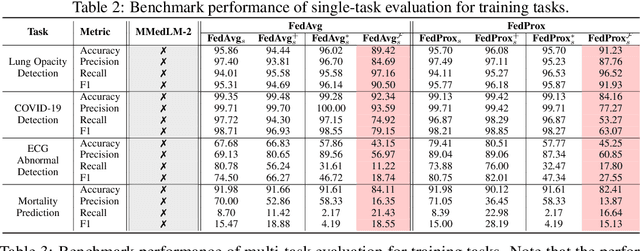

Abstract:This study introduces the Federated Medical Knowledge Injection (FEDMEKI) platform, a new benchmark designed to address the unique challenges of integrating medical knowledge into foundation models under privacy constraints. By leveraging a cross-silo federated learning approach, FEDMEKI circumvents the issues associated with centralized data collection, which is often prohibited under health regulations like the Health Insurance Portability and Accountability Act (HIPAA) in the USA. The platform is meticulously designed to handle multi-site, multi-modal, and multi-task medical data, which includes 7 medical modalities, including images, signals, texts, laboratory test results, vital signs, input variables, and output variables. The curated dataset to validate FEDMEKI covers 8 medical tasks, including 6 classification tasks (lung opacity detection, COVID-19 detection, electrocardiogram (ECG) abnormal detection, mortality prediction, sepsis prediction, and enlarged cardiomediastinum detection) and 2 generation tasks (medical visual question answering (MedVQA) and ECG noise clarification). This comprehensive dataset is partitioned across several clients to facilitate the decentralized training process under 16 benchmark approaches. FEDMEKI not only preserves data privacy but also enhances the capability of medical foundation models by allowing them to learn from a broader spectrum of medical knowledge without direct data exposure, thereby setting a new benchmark in the application of foundation models within the healthcare sector.
FEDKIM: Adaptive Federated Knowledge Injection into Medical Foundation Models
Aug 17, 2024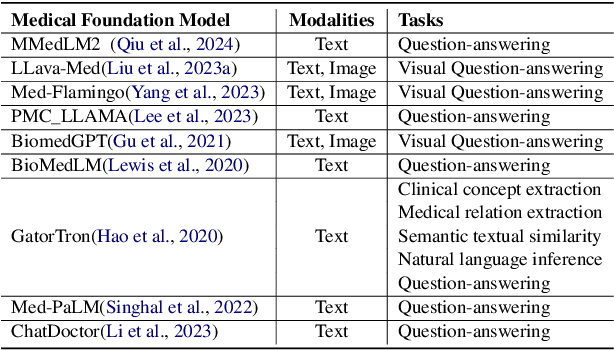
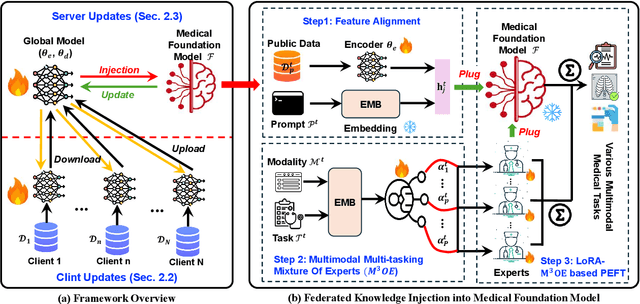
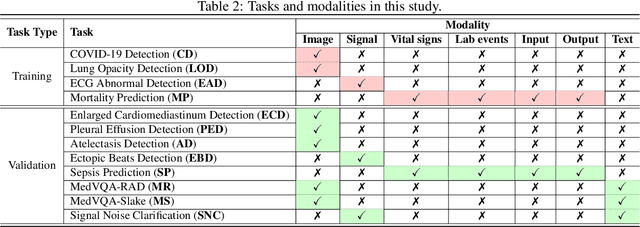
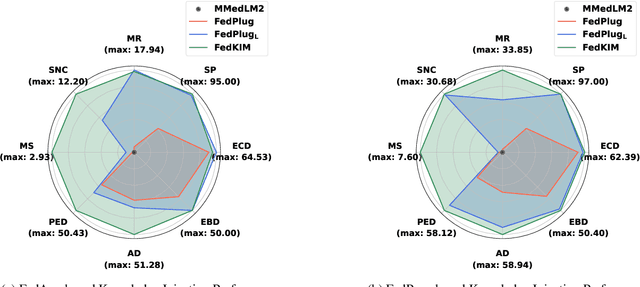
Abstract:Foundation models have demonstrated remarkable capabilities in handling diverse modalities and tasks, outperforming conventional artificial intelligence (AI) approaches that are highly task-specific and modality-reliant. In the medical domain, however, the development of comprehensive foundation models is constrained by limited access to diverse modalities and stringent privacy regulations. To address these constraints, this study introduces a novel knowledge injection approach, FedKIM, designed to scale the medical foundation model within a federated learning framework. FedKIM leverages lightweight local models to extract healthcare knowledge from private data and integrates this knowledge into a centralized foundation model using a designed adaptive Multitask Multimodal Mixture Of Experts (M3OE) module. This method not only preserves privacy but also enhances the model's ability to handle complex medical tasks involving multiple modalities. Our extensive experiments across twelve tasks in seven modalities demonstrate the effectiveness of FedKIM in various settings, highlighting its potential to scale medical foundation models without direct access to sensitive data.
Synthesizing Multimodal Electronic Health Records via Predictive Diffusion Models
Jun 20, 2024



Abstract:Synthesizing electronic health records (EHR) data has become a preferred strategy to address data scarcity, improve data quality, and model fairness in healthcare. However, existing approaches for EHR data generation predominantly rely on state-of-the-art generative techniques like generative adversarial networks, variational autoencoders, and language models. These methods typically replicate input visits, resulting in inadequate modeling of temporal dependencies between visits and overlooking the generation of time information, a crucial element in EHR data. Moreover, their ability to learn visit representations is limited due to simple linear mapping functions, thus compromising generation quality. To address these limitations, we propose a novel EHR data generation model called EHRPD. It is a diffusion-based model designed to predict the next visit based on the current one while also incorporating time interval estimation. To enhance generation quality and diversity, we introduce a novel time-aware visit embedding module and a pioneering predictive denoising diffusion probabilistic model (PDDPM). Additionally, we devise a predictive U-Net (PU-Net) to optimize P-DDPM.We conduct experiments on two public datasets and evaluate EHRPD from fidelity, privacy, and utility perspectives. The experimental results demonstrate the efficacy and utility of the proposed EHRPD in addressing the aforementioned limitations and advancing EHR data generation.
Leveraging Foundation Models for Multi-modal Federated Learning with Incomplete Modality
Jun 16, 2024Abstract:Federated learning (FL) has obtained tremendous progress in providing collaborative training solutions for distributed data silos with privacy guarantees. However, few existing works explore a more realistic scenario where the clients hold multiple data modalities. In this paper, we aim to solve a novel challenge in multi-modal federated learning (MFL) -- modality missing -- the clients may lose part of the modalities in their local data sets. To tackle the problems, we propose a novel multi-modal federated learning method, Federated Multi-modal contrastiVe training with Pre-trained completion (FedMVP), which integrates the large-scale pre-trained models to enhance the federated training. In the proposed FedMVP framework, each client deploys a large-scale pre-trained model with frozen parameters for modality completion and representation knowledge transfer, enabling efficient and robust local training. On the server side, we utilize generated data to uniformly measure the representation similarity among the uploaded client models and construct a graph perspective to aggregate them according to their importance in the system. We demonstrate that the model achieves superior performance over two real-world image-text classification datasets and is robust to the performance degradation caused by missing modality.
Personalized Steering of Large Language Models: Versatile Steering Vectors Through Bi-directional Preference Optimization
May 28, 2024



Abstract:Researchers have been studying approaches to steer the behavior of Large Language Models (LLMs) and build personalized LLMs tailored for various applications. While fine-tuning seems to be a direct solution, it requires substantial computational resources and may significantly affect the utility of the original LLM. Recent endeavors have introduced more lightweight strategies, focusing on extracting "steering vectors" to guide the model's output toward desired behaviors by adjusting activations within specific layers of the LLM's transformer architecture. However, such steering vectors are directly extracted from the activations of human preference data and thus often lead to suboptimal results and occasional failures, especially in alignment-related scenarios. This work proposes an innovative approach that could produce more effective steering vectors through bi-directional preference optimization. Our method is designed to allow steering vectors to directly influence the generation probability of contrastive human preference data pairs, thereby offering a more precise representation of the target behavior. By carefully adjusting the direction and magnitude of the steering vector, we enabled personalized control over the desired behavior across a spectrum of intensities. Extensive experimentation across various open-ended generation tasks, particularly focusing on steering AI personas, has validated the efficacy of our approach. Moreover, we comprehensively investigate critical alignment-concerning scenarios, such as managing truthfulness, mitigating hallucination, and addressing jailbreaking attacks. Remarkably, our method can still demonstrate outstanding steering effectiveness across these scenarios. Furthermore, we showcase the transferability of our steering vectors across different models/LoRAs and highlight the synergistic benefits of applying multiple vectors simultaneously.
 Add to Chrome
Add to Chrome Add to Firefox
Add to Firefox Add to Edge
Add to Edge